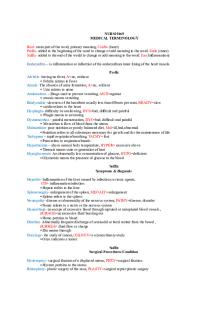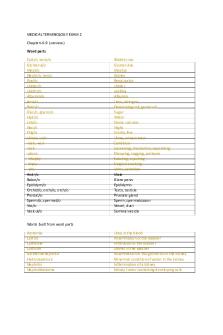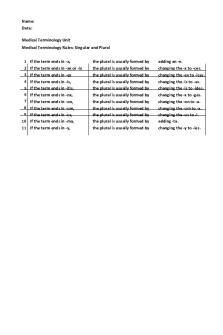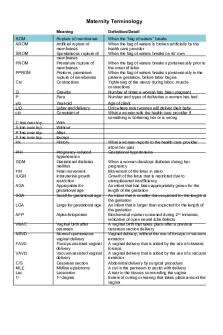Medical Terminology Notes PDF

| Title | Medical Terminology Notes |
|---|---|
| Course | Medical Terminology |
| Institution | California Polytechnic State University San Luis Obispo |
| Pages | 79 |
| File Size | 2 MB |
| File Type | |
| Total Downloads | 74 |
| Total Views | 129 |
Summary
Notes from online class. ...
Description
Chapter 1 ● 5 medical language skills ○ reading ○ listening ○ thinking/analysing and understanding ○ writing (or typing) and spelling ○ speaking and pronouncing ● Which syllable is the primary accented syllable in the medical word arthropathy? THRAW ● In what order should you put the meanings of the word parts to get the definition of the entire medical word? --suffix, prefix, combining form ● Which syllable is the primary accented syllable in the medical word urination? NAY https://en.wikipedia.org/wiki/List_of_medical_roots,_suffixes_and_prefixes ● ● ● ● ● ● ● ● ● ● ● ●
peri - to surround cardio - heart ium - a smaller portion of a larger system pericardium - a sac that surrounds the heart ectomy, which means "surgical removal or excision," intra-, means "within." The suffix -scopy means the process of using an instrument to examine. The suffix -gram means a record or picture. The suffix -oma means tumor; mass.
Combining Form
Meaning
Word using this form
cardi/o-
heart
electrocardiogram
gastr/o-
stomach
gastric
nas/o-
nose
nasal
hepat/o-
liver
hepatitis
arthr/o-
joint
arthritis
col/o-
large intestine
colostomy
dermat/o-
skin
dermatologist
CC Chief Complaint — why the patient came to the physician/hospital HPI History of Present Illness — a summary of signs and symptoms for this illness prior to the current hospitalization PMH Past Medical History — a list of other health problems throughout life as well as a list of surgeries
SH Social history (work, school, activities) and FH Family history (family composition and illnesses) ROS Review of Systems — a summary of significant findings in each body system PE Physical Examination — the results of the physician's examination of the patient Lab and X-ray data All test results Dx Diagnosis — a formal statement of what the physician has determined is the problem Disposition The outcome for the patient (discharged to home or nursing facility; expired)
CHAPTER 2
https://quizlet.com/147189378/medical-terminology-ch2-body-directions-structures-andterminology-flash-cards/ ● ●
Cranial cavity: The major organ here is the brain contained in the cranium. Spinal cavity: The spinal cord lies in here and it is attached to the brain. Many spinal nerves leave the spinal cavity to go to the rest of the body.
●
● ●
●
Thoracic cavity: The lungs and heart are the major organs protected by the breast bone, ribs and thoracic spinal column. Other organs, such as the esophagus and trachea, and important blood vessels go through this cavity also. Abdominal cavity: The diaphragm separates the thoracic cavity from the abdominal cavity. The digestive organs fill most of this cavity. Pelvic cavity: Unseparated from the abdominal cavity, this space lies inferior to the abdominal cavity. The urinary and reproductive organs are the major organs here, although there are some digestive organs as well Abdominopelvic cavity: Yes, this is a combination of the abdominal and pelvic cavities.
RUQ
right upper quadrant
Contains liver, gallbladder, small and large intestines
LUQ
left upper quadrant
Contains stomach, pancreas, spleen, small and large intestines
RLQ
right lower quadrant
Contains small and large intestines, appendix, female ovary and uterus, bladder
LLQ
left lower quadrant
Contains small and large intestines, female ovary and uterus, bladder
hypochondriac region
right and left regions below the ribs
lumbar region
right and left regions at the waist
inguinal region or iliac
most inferior right and left regions
epigastric region
most superior medial region
umbilical region
central region around the belly button
hypogastric region
most inferior medial region
Where we live and work and what we eat can contribute to environmental disorders and nutritional disease. A communicable disease or infectious disease is caused by a pathogen, while the etiology of degenerative diseases can be the normal aging process or a destruction of body cells. Lastly, most people fear a neoplastic disease, which, while it can be benign or malignant, is feared as cancer. Exam steps: inspection, palpation, auscultation and percussion.
a disease or condition that does not respond to treatment - refractory
physician’s assistant (PA), certified registered nurse anesthetist (CRNA), certified nurse midwife (CNM), and nurse practitioner (NP).
The medical language definition of the word respiratory is __________. pertaining to again and again breathing (suffix ((pertaining to)), prefix, combining form)
Attending physician - physician who is on the medical staff of a hospital and admits a patient to the hospital The human body can be studied by dividing the anterior surface of the abdomen into __________. - four quadrants and nine regions The combining form iatr/o- means __________. - physicain or treatment The midsagittal plane divides the body into __________. RIGHT AND LEFT The region of the abdominopelvic area that is centered and inferior to the umbilical region is the __________ region. Ophthalmology EYES A symptom is any deviation from health that is experienced or felt by the patient. An example of a symptom would be pain felt in the joints. An irregular heartbeat and coughing up blood are signs that can be observed by others AND THEREFORE NOT SYMPTOMS
When The Doctor Orders An AP X-ray Enter The Patient's Body From The? FRONT Refractory Means? resistant to treatment A Person Lying Face Down Is In What Position? prone
approaches for studying body
a. microscopic to macroscopic approach b. disease approach NOT A VALID APPROACH c. anatomy and physiology approach d. body systems approach
CHAPTER 3 The gastrointestinal system is also known as the GI system. It is divided into two parts: the upper GI and the lower GI systems. The upper GI system begins at the mouth with the teeth and tongue, and proceeds to the stomach via the pharynx and esophagus. These structures prepare food for further processing and digestion. The lower GI system includes the small and large intestines, rectum, and anus. These structures are responsible for digestion and absorption of nutrients as well as removing undigested waste products.
Sialolith – a stone that forms in the slivary gland Chime – combination of partially digested food, saliva and digestive enzymes in the stomach and small intestine https://quizlet.com/147203871/medical-terminology-ch3-gi-flash-cards/ The teeth are NOT responsible for deglutition. Hormone in stomach that stimulates acid production GASTRIN Substance produced by liver that breaks down fat BILE Pancreatic enzyme that breaks down fat LIPASE Mastication - chewing The esophagus is a muscular tube that extends from the inferior pharynx down to the stomach. The pharynx serves as a passageway for food on its way to the esophagus and stomach and also serves as a passageway for air from the nasal cavity on its way to the windpipe and lungs. As pointed out previously, the epiglottis makes sure that food goes only into the esophagus. The esophagus uses peristalsis to push each swallow of food downward toward the entrance into the stomach
The Stomach
Before food can enter the stomach, the lower esophageal sphincter or LES (also called the cardiac sphincter) must open. This sphincter ensures that the stomach contents stay in the stomach and do not flow backward into the esophagus, where they can burn the esophageal lining and cause heartburn. The stomach can expand because of its rugae. Food mixes with acid and digestive enzymes in the stomach until the mixture becomes chyme. Notice in the diagram that the stomach is composed of four sections: the cardia, the fundus, the body, and the pylorus. Chyme leaves the stomach through the pyloric sphincter and enters the small intestine
Small Intestine After passing through the pyloric sphincter, chymeenters the first part of the small intestine, the duodenum. This first part is only 10 inches long, but it is a very important part. Bile from the liver and gallbladder and digestive enzymes from the pancreas empty into the duodenum through small tubes with openings called ducts. These digestive juices mix with the chyme to continue the digestive process. As in the esophagus, chyme moves through the small and large intestines by means of peristalsis. Following the duodenum is the 8-foot-long jejunum where digestion continues as the chyme moves slowly through this section. The last section of the small intestines is the 12-foot-long ileum where water and nutrients are absorbed into the bloodstream to be carried throughout the body. Specialized structures that project into the lumen of the ileum, called villi, increase surface area for more efficient absorption. It's amazing that almost 21 feet of small intestine fits into the abdomen!
Large Intestine The large intestine or colon receives leftover digestive waste from the ileum. Inferior to the entrance of the ileum is the cecum and appendix. The very watery waste moves upward in the first part of the colon, the ascending colon. Without peristalsis, this wouldn't be possible. As the waste moves through this part and into the transverse colon and descending colon, more and more water is reabsorbed into the body, making the waste semi-solid. This waste is temporarily stored in the last section of the colon, the sigmoid colon, which is an s shape. Finally, the waste moves into the rectum which is responsible for pushing the feces or stool through the anus and out of the body.
The Abdomen The digestive organs are contained in the abdomen. Note that the abdomen is a very large area that is part of the abdominopelvic cavity. This cavity is lined with a double-layered peritoneum. One layer covers all the digestive organs, and the second layer lines the abdominal cavity. The omentum covers and protects the small intestine, while the mesentery keeps the jejunum and ileum in place.
The Liver and Gallbladder The liver is a fairly large organ in the upper abdomen. Located primarily on the right side, the liver produces a green, slimy, and smelly substance called bile. Bile is necessary for the digestion of fat. While the liver has many other functions, the bile it produces travels through the hepatic ducts to the gallbladder and duodenum. The gallbladder is a small, pear-shaped organ located underneath the liver. The green sac collects bile, concentrates it, and sends it to the duodenum through the cystic duct and common bile duct when needed. All of these ducts together are called the biliary tree. Find all of these structures in the figure at right.
The Pancreas The pancreas is an interesting organ. It is located behind the stomach so it is always hard to see in an illustration of abdominal organs.
The pancreas serves double duty as an organ in the digestive system as well as being an organ in the endocrine system. In the digestive system, the pancreas is responsible for producing a number of digestive enzymes which it sends to the duodenum through the pancreatic ducts
Digestion in the Duodenum and Intestines The duodenum may only be 10 inches long, but it is a very busy place. When there is fat in the chyme released from the stomach, a special hormone, cholecystokinin, causes the gallbladder to contract. Bile is sent through the cystic and common bile ducts into the duodenum in order to break down fatty substances. Chyme also stimulates the release of amylase, lipase, and protein-digesting enzymes from the pancreas. These enzymes empty into the duodenum through the pancreatic duct. Another enzyme, lactase, is made by the intestinal villi to digest sugars.
Diseases — Eating and Oral Disorders Anorexia can occur with many types of illnesses, sometimes even with a mild illness like a cold. On the other hand, dysphagia and polyphagia are usually symptomatic of a more serious disorder. Dry air, inflammation, allergies, or nutritional deficiencies can result in cheilitis. Inside the mouth itself, glossitis and stomatitis can result in anorexia! Facial pain, when sitting down and beginning to eat, can be caused by sialolithiasis.
Diseases – Esophagus and Stomach Other than birth defects or cancer, there are not a lot of diseases of the esophagus. One important disorder, however, is esophageal varices. These are caused by some type of liver disease. The problem is that the varices can rupture, causing major bleeding. And heartburn seems to be a common problem for a lot of people, gauging by the number of drug ads on television. When we move to the stomach, it's not surprising that nausea and vomiting, as well as dyspepsia, are usually experienced by all of us at some time. Vomitus (also known as emesis) will contain whatever is in the stomach at the time of vomiting. The emesis can even be hematemesis. Babies frequently have regurgitation after breast or bottle-feeding, although adults can have this problem also.
A more serious version of heartburn is chronic gastroesophageal reflux disease (known as GERD). Gastritis and gastroenteritis are frequently due to bacterial or viral infections, although increased stomach acid can contribute to gastritis. Very serious stomach disorders include peptic ulcer disease (PUD) also known as a stomach or gastric ulcer. A bleeding ulcer and even perforation of the stomach are two potentially serious consequences of an untreated ulcer. A peptic ulcer can also occur in the esophagus or duodenum. The most serious disease, of course, is stomach cancer, which is gastric adenocarcinoma. It can be fatal without treatment. Inflammation of the lips CHEILITIS Excessive or frequent food intake POLYPHAGIA Enlarged, twisted veins in the lower esophagus VARICES Upset stomach DYSPEPSIA Formation of a stone or stones in the salivary gland or duct SIALOLITHIASIS Inflammation of the lining of the mouth STOMATITIS Dark, tarry feces that contain digested blood. MELENA
Reflux of stomach contents into the esophagus is called GERD Difficulty swallowing or eating is medically known as DYSPHAGIA Inflammation of the tongue is GLOSSITIS
Diseases – Small Intestine Disorders of the small intestine are some of the more interesting gastrointestinal disorders. Ileus, sometimes called paralytic or postoperative ileus, is a complete absence of peristalsis in the lower small intestine. Anesthesia, abdominal surgery and trauma are common causes. Treatment may be needed to restart bowel activity. Sometimes the small intestine starts to turn itself inside out. This disorder has the long name intussusception, which is a great spelling word! Unless it resolves by itself or through surgical intervention, part of the intestine can become inflamed and even die. Volvulus occurs when part of the small intestine gets twisted. This sometimes happens to horses when they have a change in their feed that leads to colic because their colons are very loosely attached and can easily rotate around in the abdominal cavity. Again, twisting can result in part of the intestine dying.
Diseases – Cecum and Colon Attached to the inferior portion of the ascending colon, where the ileum joins the colon, the cecum is the location of the appendix. A common disorder, of course, is appendicitis. Diagnosed with lower right quadrant pain, and possibly nausea and vomiting, the appendix is usually removed, because a burst appendix can cause a very serious case of peritonitis, which can be fatal if not treated. A diverticulum is a small outward pouch that develops in the colon. Food fibers and seeds can get caught in this pouch and can cause diverticulitis. A polyp is, in a way, the reverse of a diverticulum. Polyps are small growths that protrude into the lumen of the colon. They are usually removed during a colonoscopy as they are sometimes precancerous. Inflammatory bowel disease (IBD) is a general term for a number of disorders of the bowel. Crohn's disease or regional enteritis affects the ileum and colon, and causes a lot of distress due to inflammation and ulcers. Ulcerative colitis on the other hand affects the colon and rectum, again producing inflammation and ulcers that can bleed. A noninflamed colon may have painful spasms. Irritable bowel syndrome (IBS) produces pain, bloating and diarrhea, which alternates with constipation. Colon cancer is particularly dangerous because the person may not have any symptoms until the cancer is very advanced. A common place for cancer development is in the area of the rectum and sigmoid colon, called colorectal cancer. A common disorder in babies that causes much stress for parents is colic. A serious form of diarrhea is dysentery. A person can become dehydrated very quickly. Antibiotic treatment is required. Gluten sensitivity, or celiac disease, has become more prominent, and many foods are being offered as gluten free.
Diseases – The Abdomen Peritonitis is a very serious infection of the entire peritoneum, which can be fatal at times. It is most often caused by a rupture of the appendix or intestine, or even a perforated ulcer. Less life-threatening is a hernia, although sometimes the symptoms can be very disturbing to a person, and a few hernias can endanger the health of the intestine. There are many types of hernias, but the most common are the following. A hiatal hernia is an interesting disorder, since the symptoms involve the heart and lungs. With the esophagus and stomach protruding into the chest cavity, a person can have a change in breathing or heart rhythm patterns. umbilical hernia inguinal hernia
Adhesions can form after surgery or an infection. These scars can tighten over time and cause a constriction of the intestine or other organs.
Diseases – The Liver No one can live without a liver. Since a liver has many functions, a healthy and functioning liver is a necessity for life. Cirrhosis of the liver causes irreversible damage. While alcoholism is a common cause, hepatitis and other factors can result in cirrhosis. Five types of hepatitis make this disease the most common liver disease. Infection is contracted by different forms of exposure to the five types, although hepatitis E seldom occurs in the United States. Three symptoms associated with liver disease are ascites, jaundice, and hepatomegaly. Jaundice is yellowing of the skin from bile pigments, but it is difficult to assess in persons of color. Checking the whites of the eyes for yellowish discoloration is an easy way to assess anyone. Liver cancer usually starts elsewhere in the body and happens to spread to the liver. Treatment is difficult. ASCITES accumulation of fluid in the abdomen
Diseases – Gallbladder and Pancreas Since bile is concentrated while being stored in the gallbladder, minerals in the bile are concentrated also, and sometimes form stones. Cholelithiasis can, in turn, result in cholecystitis or choledocholithiasis. Treatment for any of these disorders is a cholecystectomy, usually done through small incisions in the abdomen. Pancreatitis requires vigorous treatment for this inflammation/infection. Severe vomiting can cause a serious fluid and electrolyte imbalance. Probably one of the worst cancer diagnoses to receive is cancer of the pancreas. Treatment is generally ineffective, with about a 4% success rate.
Laboratory and Diagnostic Procedures Blood tests are often the first considerations when a physician is trying to make a diagnosis. The tests are the easiest procedures for the patient. Primarily,...
Similar Free PDFs

Medical Terminology Notes
- 20 Pages

Medical Terminology Notes
- 79 Pages

Medical Terminology Full Notes
- 37 Pages

Medical Terminology
- 50 Pages

Medical Terminology
- 6 Pages

Medical Terminology
- 2 Pages

Medical Terminology
- 4 Pages

Medical terminology chpt 11 notes
- 12 Pages

Medical Terminology Exam 1 Notes
- 11 Pages

Medical Terminology EXAM 2
- 4 Pages

Medical terminology Modules
- 158 Pages

Medical Terminology Terms
- 22 Pages

Medical Terminology-Plurals Quiz
- 3 Pages
Popular Institutions
- Tinajero National High School - Annex
- Politeknik Caltex Riau
- Yokohama City University
- SGT University
- University of Al-Qadisiyah
- Divine Word College of Vigan
- Techniek College Rotterdam
- Universidade de Santiago
- Universiti Teknologi MARA Cawangan Johor Kampus Pasir Gudang
- Poltekkes Kemenkes Yogyakarta
- Baguio City National High School
- Colegio san marcos
- preparatoria uno
- Centro de Bachillerato Tecnológico Industrial y de Servicios No. 107
- Dalian Maritime University
- Quang Trung Secondary School
- Colegio Tecnológico en Informática
- Corporación Regional de Educación Superior
- Grupo CEDVA
- Dar Al Uloom University
- Centro de Estudios Preuniversitarios de la Universidad Nacional de Ingeniería
- 上智大学
- Aakash International School, Nuna Majara
- San Felipe Neri Catholic School
- Kang Chiao International School - New Taipei City
- Misamis Occidental National High School
- Institución Educativa Escuela Normal Juan Ladrilleros
- Kolehiyo ng Pantukan
- Batanes State College
- Instituto Continental
- Sekolah Menengah Kejuruan Kesehatan Kaltara (Tarakan)
- Colegio de La Inmaculada Concepcion - Cebu


